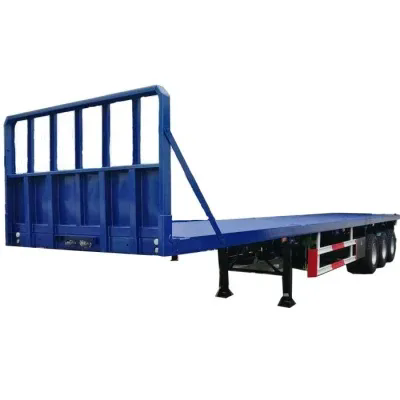Product Center
Tanker Trailer
- Fuel Tanker Trailer
- Cement Bulker Trailer
- Alu Tanker Trailer
- S/S Tanker Trailer
- Asphalt Tank Trailer
- Sulfuric Acid Tanker
Container & Bulk Trailer
- Flatbed Semi Trailer
- Fence Semi Trailer
- Sidewall Semi Trailer
- Skeleton Trailer
- Grain Trailer
- Side Tipper Trailer
- Tipper Semi Trailer
Heavy Duty Trailer
- Low Bed Semi Trailer
- Removable Gooseneck Trailer
- Hydraulic Modular
- Extendable Trailer
- Side Lifter Trailer
- Windmill Blade Adapter
Special Trailers
The basic structure of a Flatbed semi trailer: Know your transport partner
Posted on 2025-05-13
keywords : Flatbed semi trailer
A Flatbed semi trailer is an indispensable tool in logistics transportation, and its structural design directly affects the safety and efficiency of transportation. So, what is the basic structure of a Flatbed semi trailer? Let's talk about its various parts below.
1. Traction device
The traction device is the key to connecting the Flatbed semi trailer and the tractor. It includes a drawbar, a drawbar pin, and a hook. The drawbar is usually in front of the trailer and is connected to the fifth wheel of the tractor through the drawbar pin to ensure that the connection between the trailer and the tractor is stable. The design of the traction device must meet safety standards to ensure a secure connection under various road conditions.
2. Cargo platform
The cargo platform is the core of the Flatbed semi trailer and is used to load cargo. The platform is usually made of high-strength steel with a flat surface for easy loading and unloading of cargo. The size and shape of the platform will vary according to different transportation needs, and some platforms will also be equipped with guardrails or baffles to make the cargo safer.

3. Suspension system
The suspension system is responsible for supporting the weight of the vehicle and absorbing the bumps generated when driving, making the vehicle more stable. The suspension system of a Flatbed semi trailer usually uses air suspension or leaf spring suspension. Air suspension has better shock absorption effect and can adapt to different load conditions; leaf spring suspension has a simple and durable structure and is suitable for pulling heavy goods.
4. Braking system
The braking system is an important part to ensure the safe driving of a Flatbed semi trailer. It includes brakes, brake lines and control devices. Brakes are usually installed on wheels to slow down or stop the vehicle through friction. The braking system of a Flatbed semi trailer is usually connected to the braking system of the tractor, so that it can brake quickly and effectively in an emergency.
5. Tires and wheels
Tires and wheels are the basis for the driving of Flatbed semi trailers. The choice of tires directly affects how much cargo the vehicle can pull, whether it drives steadily and whether it saves fuel. The wheel hub is responsible for fixing the tires and transmitting the rotation of the tires to the vehicle. Tires and wheels need to be checked and maintained regularly to ensure that they are in good condition.
6. Lighting and signal system
The lighting and signal system includes front and rear headlights, turn signals, brake lights, width lights and reflective signs. These devices are particularly important at night or when visibility is poor, to ensure that the vehicle can be seen and driven safely. The lighting and signal system needs to be checked regularly to ensure that all lights are on.
7. Outriggers
Outriggers are devices used to support the Flatbed semi trailer when it is parked. When the tractor and trailer are separated, the outriggers can be lowered to ensure that the trailer is parked firmly on the ground. The outriggers must be designed to be strong enough to withstand the weight of the trailer.
The structural design of the Flatbed semi trailer is complex and sophisticated, and each component is very important. Understanding the basic structure of the Flatbed semi trailer can help the driver better operate and maintain the vehicle, ensuring safe and efficient transportation.
First Page:Notes on loading and unloading of Flatbed semi trailers
Nest Page:没有了

